Abstract
1 There is evidence, from human and animal studies, that drug-metabolising enzymes exist in multiple forms, the individual enzymes having selective, but not specific, substrate requirements. Consequently drug interactions may arise when two drugs bind to the same enzyme. The degree of enzyme inhibition will be partly dependent on the relative affinities of the drugs for the enzyme and on their rates of turnover. The decrease in drug clearance produced by enzyme inhibition is dependent on the fraction of the drug normally metabolised by the inhibited pathway(s).
2 Cimetidine, a P-450 enzyme inhibitor, increases the systemic bioavailability of propranolol and labetalol, which undergo extensive metabolism, but does not affect the clearance of atenolol, which is excreted largely unchanged. In this situation, both the extent and type of biotransformation are important. Thus, cimetidine has no effect on the clearance of penbutolol, even though the drug is eliminated almost entirely by biotransformation. The major metabolite is penbutolol glucuronide, and it has been shown recently that cimetidine does not inhibit glucuronylation.
3 β-adrenoceptor blockers also act as enzyme inhibitors themselves. For example, antipyrine clearance is decreased by propranolol and to a lesser extent by metoprolol, whereas atenolol has no effect. It has been suggested, therefore, that there is a relationship between the lipid-solubility of β-adrenoceptor blockers and their ability to inhibit drug metabolism.
4 The clearance of lipophilic β-adrenoceptor blockers is dependent on hepatic enzyme activity, and is therefore sensitive to enzyme induction. For drugs with high hepatic clearance and subsequent high presystemic elimination, a moderate increase in the extraction ratio will produce a marked decrease in systemic bioavailability. Thus pentobarbitone enzyme induction increased the hepatic extraction of alprenolol by 29% and decreased the AUC by 78%.
5 The impact of changes in the activity of the drug-metabolising enzymes on drug clearance is dependent upon the extent and type of biotransformation(s) that the interacting drugs undergo. A better understanding of such drug interactions will be obtained by measuring metabolite formation rather than clearance of parent drug.
Keywords: antipyrine, β-adrenoceptor blockers, biotransformation, pharmacodynamics, pharmacokinetics
Full text
PDF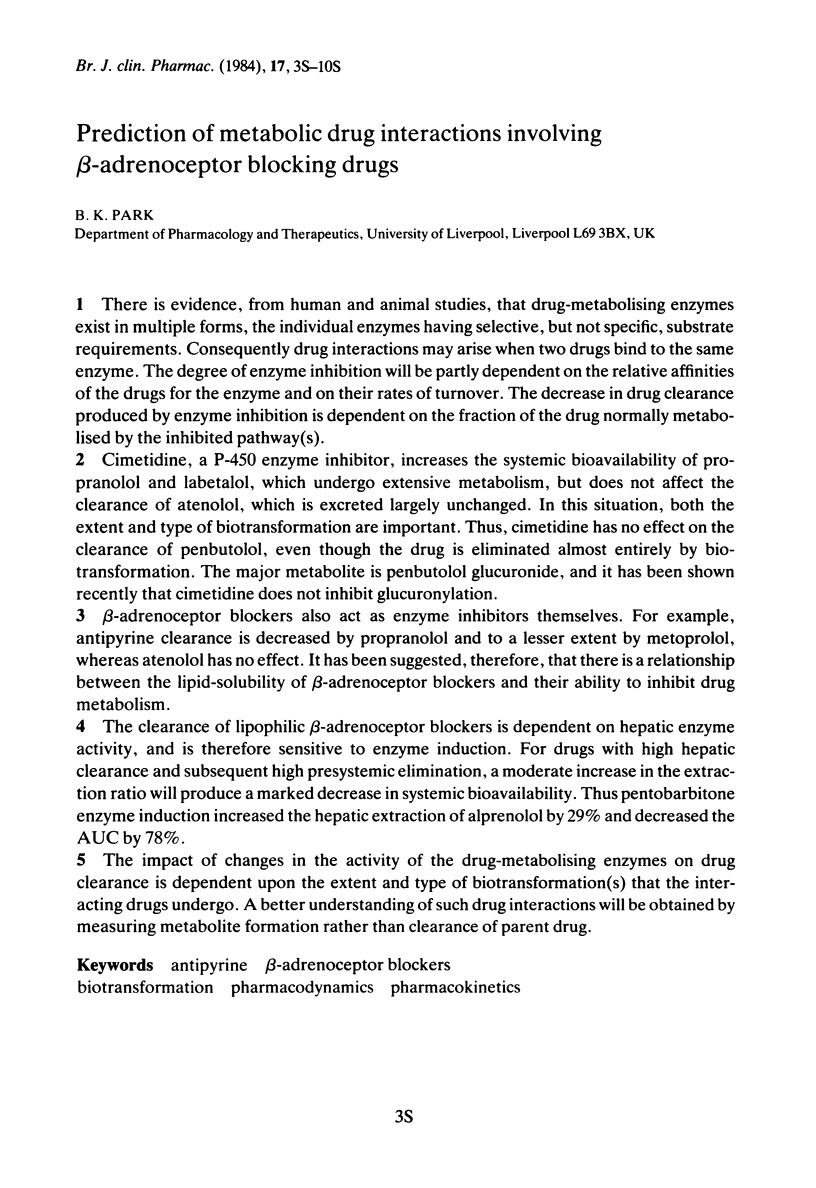
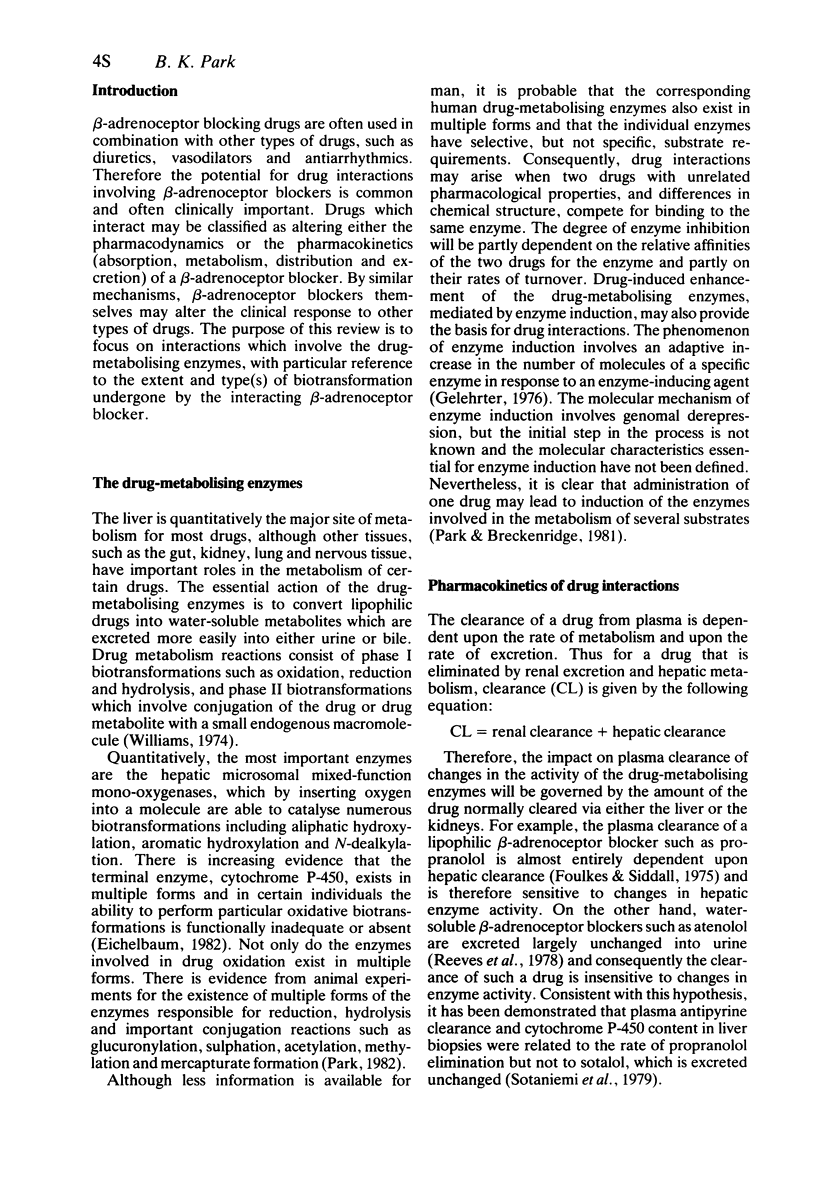
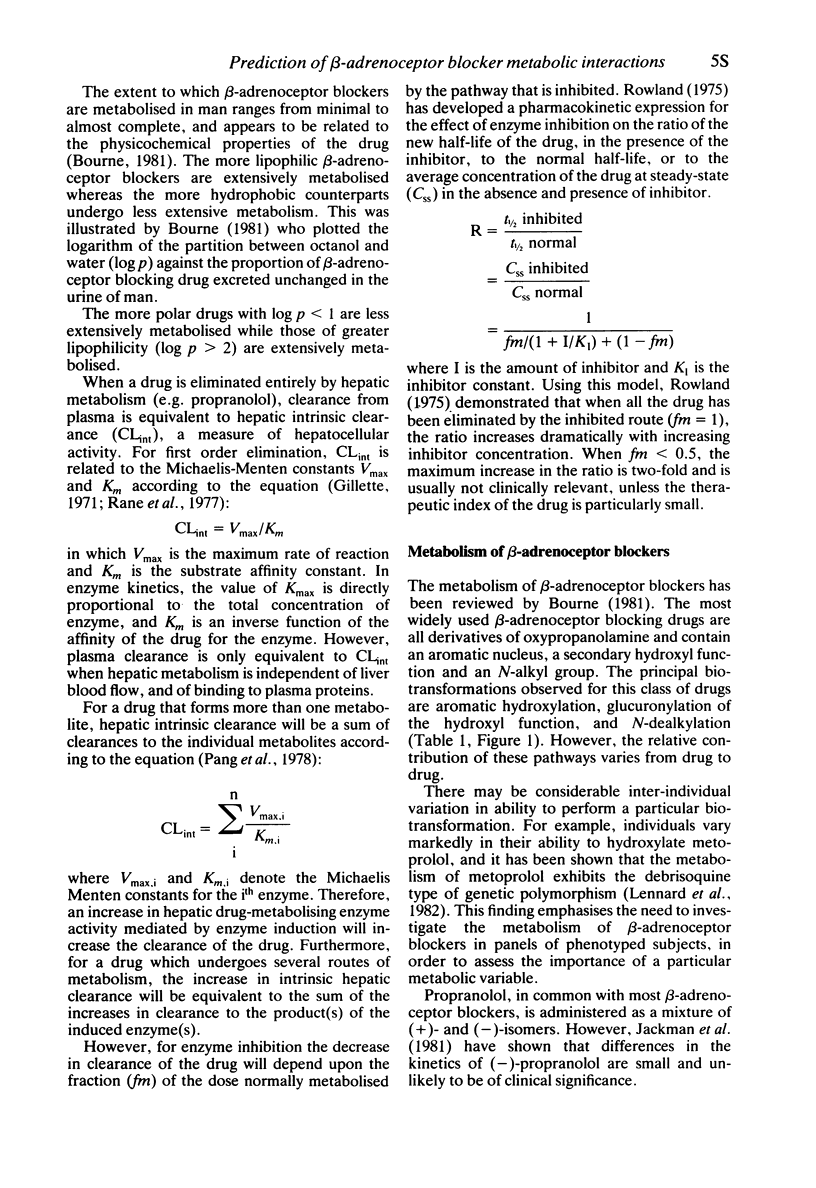
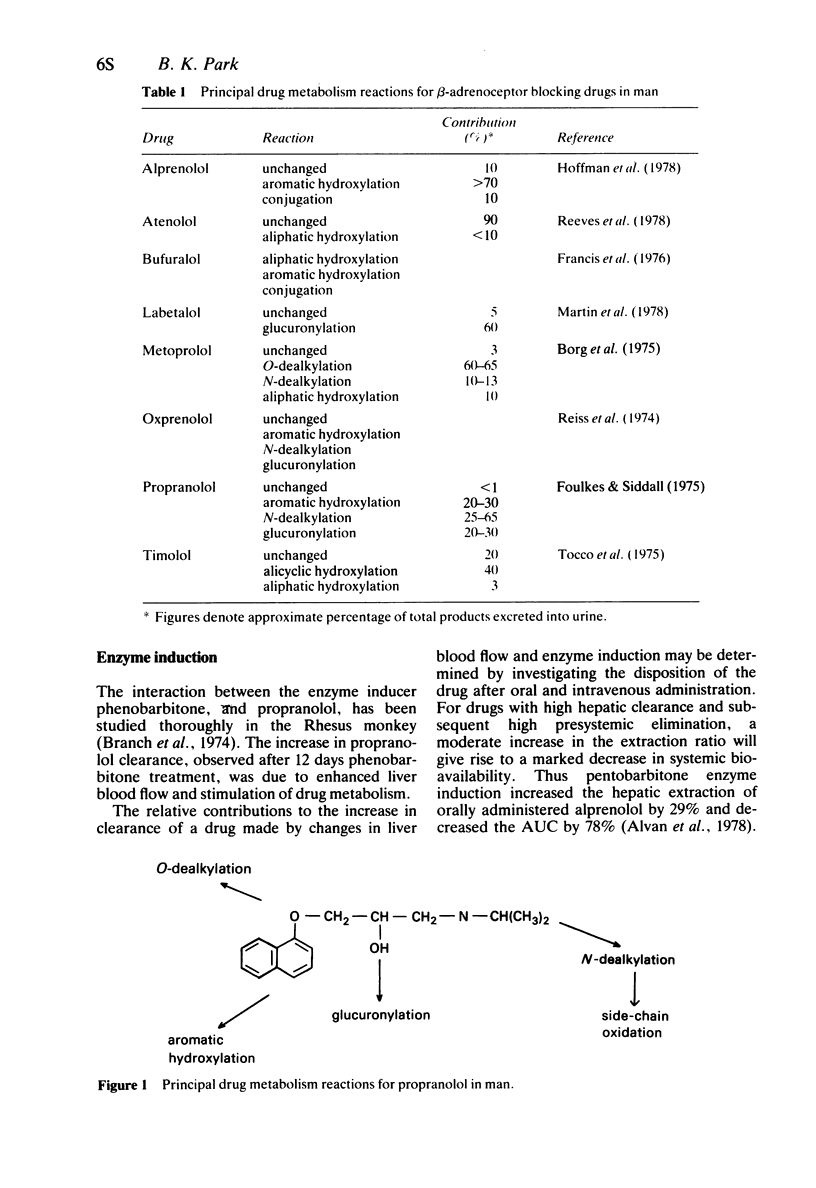
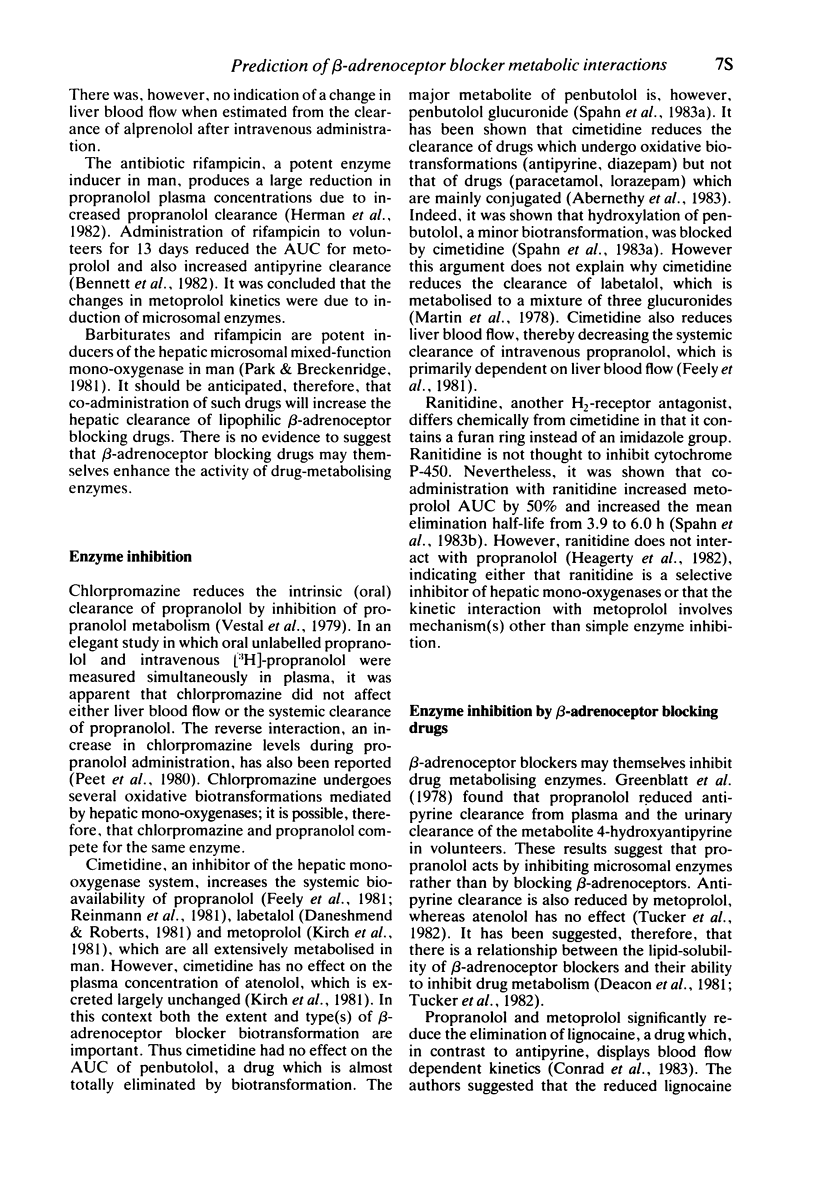

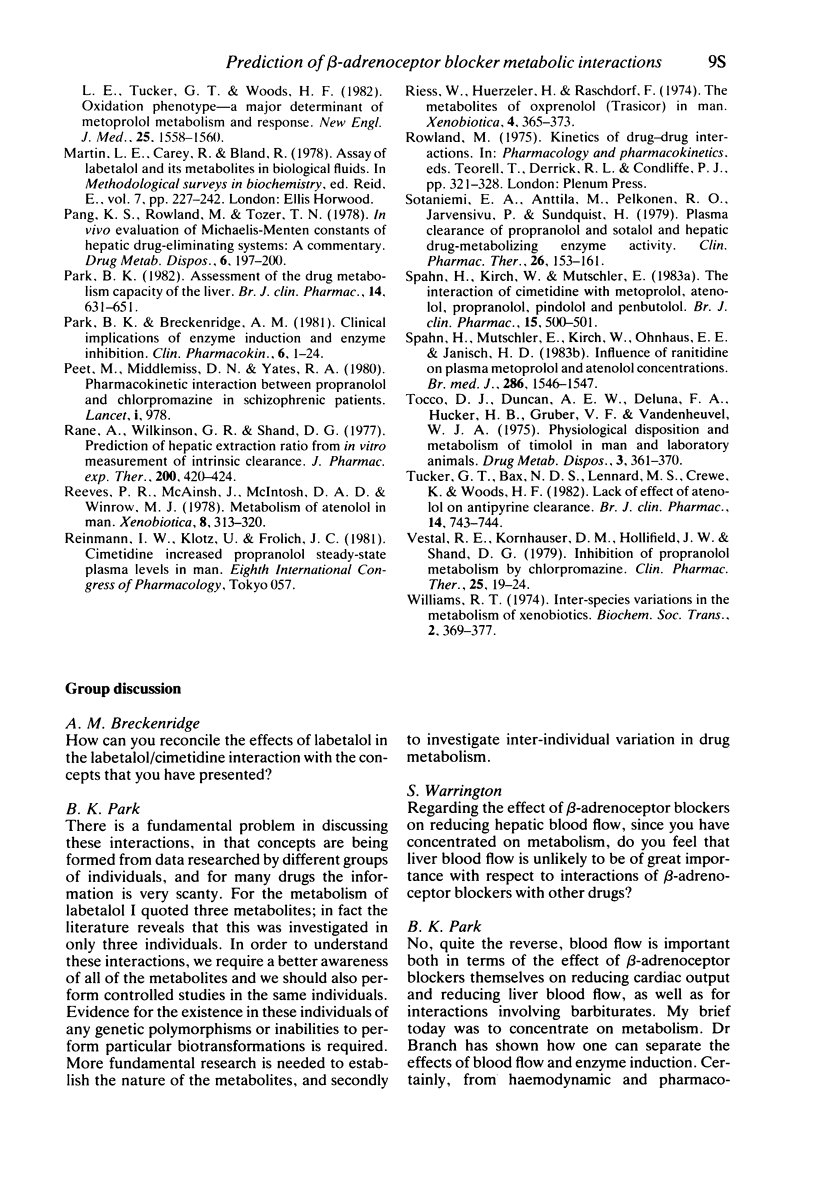
Selected References
These references are in PubMed. This may not be the complete list of references from this article.
- Abernethy D. R., Greenblatt D. J., Divoll M., Ameer B., Shader R. I. Differential effect of cimetidine on drug oxidation (antipyrine and diazepam) vs. conjugation (acetaminophen and lorazepam): prevention of acetaminophen toxicity by cimetidine. J Pharmacol Exp Ther. 1983 Mar;224(3):508–513. [PubMed] [Google Scholar]
- Alván G., Piafsky K., Lind M., von Bahr C. Effect of pentobarbital on the disposition of alprenolol. Clin Pharmacol Ther. 1977 Sep;22(3):316–321. doi: 10.1002/cpt1977223316. [DOI] [PubMed] [Google Scholar]
- Bennett P. N., John V. A., Whitmarsh V. B. Effect of rifampicin on metoprolol and antipyrine kinetics. Br J Clin Pharmacol. 1982 Mar;13(3):387–391. doi: 10.1111/j.1365-2125.1982.tb01390.x. [DOI] [PMC free article] [PubMed] [Google Scholar]
- Borg K. O., Carlsson E., Hoffmann K. J., Jönsson T. E., Thorin H., Wallin B. Metabolism of metoprolol-(3-h) in man, the dog and the rat. Acta Pharmacol Toxicol (Copenh) 1975;36(Suppl 5):125–135. doi: 10.1111/j.1600-0773.1975.tb03329.x. [DOI] [PubMed] [Google Scholar]
- Branch R. A., Shand D. G., Wilkinson G. R., Nies A. S. Increased clearance of antipyrine and d-propranolol after phenobarbital treatment in the monkey. Relative contributions of enzyme induction and increased hepatic blood flow. J Clin Invest. 1974 Apr;53(4):1101–1107. doi: 10.1172/JCI107647. [DOI] [PMC free article] [PubMed] [Google Scholar]
- Conrad K. A., Byers J. M., 3rd, Finley P. R., Burnham L. Lidocaine elimination: effects of metoprolol and of propranolol. Clin Pharmacol Ther. 1983 Feb;33(2):133–138. doi: 10.1038/clpt.1983.20. [DOI] [PubMed] [Google Scholar]
- Conrad K. A., Nyman D. W. Effects of metoprolol and propranolol on theophylline elimination. Clin Pharmacol Ther. 1980 Oct;28(4):463–467. doi: 10.1038/clpt.1980.189. [DOI] [PubMed] [Google Scholar]
- Daneshmend T. K., Roberts C. J. Cimetidine and bioavailability of labetalol. Lancet. 1981 Mar 7;1(8219):565–565. doi: 10.1016/s0140-6736(81)92903-2. [DOI] [PubMed] [Google Scholar]
- Deacon C. S., Lennard M. S., Bax N. D., Woods H. F., Tucker G. T. Inhibition of oxidative drug metabolism by beta-adrenoceptor antagonists in related to their lipid solubility. Br J Clin Pharmacol. 1981 Sep;12(3):429–431. doi: 10.1111/j.1365-2125.1981.tb01240.x. [DOI] [PMC free article] [PubMed] [Google Scholar]
- Eichelbaum M. Defective oxidation of drugs: pharmacokinetic and therapeutic implications. Clin Pharmacokinet. 1982 Jan-Feb;7(1):1–22. doi: 10.2165/00003088-198207010-00001. [DOI] [PubMed] [Google Scholar]
- Feely J., Wilkinson G. R., Wood A. J. Reduction of liver blood flow and propranolol metabolism by cimetidine. N Engl J Med. 1981 Mar 19;304(12):692–695. doi: 10.1056/NEJM198103193041202. [DOI] [PubMed] [Google Scholar]
- Gelehrter T. D. Enzyme induction (first of three parts). N Engl J Med. 1976 Mar 4;294(10):522–526. doi: 10.1056/NEJM197603042941004. [DOI] [PubMed] [Google Scholar]
- Gillette J. R. Factors affecting drug metabolism. Ann N Y Acad Sci. 1971 Jul 6;179:43–66. doi: 10.1111/j.1749-6632.1971.tb46890.x. [DOI] [PubMed] [Google Scholar]
- Greenblatt D. J., Franke K., Huffman D. H. Impairment of antipyrine clearance in humans by propranolol. Circulation. 1978 Jun;57(6):1161–1164. doi: 10.1161/01.cir.57.6.1161. [DOI] [PubMed] [Google Scholar]
- Heagerty A. M., Castleden C. M., Patel L. Failure of ranitidine to interact with propranolol. Br Med J (Clin Res Ed) 1982 May 1;284(6325):1304–1304. doi: 10.1136/bmj.284.6325.1304. [DOI] [PMC free article] [PubMed] [Google Scholar]
- Hoffmann K. J., Arfwidsson A., Borg K. O., Skånberg I. Study of the metabolic pathways of alprenolol in man and the dog using stable isotopes. Biomed Mass Spectrom. 1978 Nov;5(11):634–640. doi: 10.1002/bms.1200051108. [DOI] [PubMed] [Google Scholar]
- Jackman G. P., McLean A. J., Jennings G. L., Bobik A. No stereoselective first-pass hepatic extraction of propranolol. Clin Pharmacol Ther. 1981 Sep;30(3):291–296. doi: 10.1038/clpt.1981.162. [DOI] [PubMed] [Google Scholar]
- Kirch W., Köhler H., Spahn H., Mutschler E. Interaction of cimetidine with metoprolol, propranolol, or atenolol. Lancet. 1981 Sep 5;2(8245):531–532. doi: 10.1016/s0140-6736(81)90921-1. [DOI] [PubMed] [Google Scholar]
- Lennard M. S., Silas J. H., Freestone S., Ramsay L. E., Tucker G. T., Woods H. F. Oxidation phenotype--a major determinant of metoprolol metabolism and response. N Engl J Med. 1982 Dec 16;307(25):1558–1560. doi: 10.1056/NEJM198212163072505. [DOI] [PubMed] [Google Scholar]
- Pang K. S., Rowland M., Tozer T. N. In vivo evaluation of Michaelis-Menten constants of hepatic drug-eliminating systems. Drug Metab Dispos. 1978 Mar-Apr;6(2):197–200. [PubMed] [Google Scholar]
- Park B. K. Assessment of the drug metabolism capacity of the liver. Br J Clin Pharmacol. 1982 Nov;14(5):631–651. doi: 10.1111/j.1365-2125.1982.tb04950.x. [DOI] [PMC free article] [PubMed] [Google Scholar]
- Park B. K., Breckenridge A. M. Clinical implications of enzyme induction and enzyme inhibition. Clin Pharmacokinet. 1981 Jan-Feb;6(1):1–24. doi: 10.2165/00003088-198106010-00001. [DOI] [PubMed] [Google Scholar]
- Peet M., Middlemiss D. N., Yates R. A. Pharmacokinetic interaction between propranolol and chlorpromazine in schizophrenic patients. Lancet. 1980 Nov 1;2(8201):978–978. doi: 10.1016/s0140-6736(80)92135-2. [DOI] [PubMed] [Google Scholar]
- Rane A., Wilkinson G. R., Shand D. G. Prediction of hepatic extraction ratio from in vitro measurement of intrinsic clearance. J Pharmacol Exp Ther. 1977 Feb;200(2):420–424. [PubMed] [Google Scholar]
- Reeves P. R., McAinsh J., McIntosh D. A., Winrow M. J. Metabolism of atenolol in man. Xenobiotica. 1978 May;8(5):313–320. doi: 10.3109/00498257809060956. [DOI] [PubMed] [Google Scholar]
- Riess W., Huerzeler H., Raschdorf F. The metabolites of oxprenolol (Trasicor) in man. Xenobiotica. 1974 Jun;4(6):365–373. doi: 10.3109/00498257409052112. [DOI] [PubMed] [Google Scholar]
- Sotaniemi E. A., Anttila M., Pelkonen R. O., Järvensivu P., Sundquist H. Plasma clearance of propranolol and sotalol and hepatic drug-metabolizing enzyme activity. Clin Pharmacol Ther. 1979 Aug;26(2):153–161. doi: 10.1002/cpt1979262153. [DOI] [PubMed] [Google Scholar]
- Spahn H., Kirch W., Mutschler E. The interaction of cimetidine with metoprolol, atenolol, propranolol, pindolol and penbutolol. Br J Clin Pharmacol. 1983 Apr;15(4):500–501. doi: 10.1111/j.1365-2125.1983.tb01539.x. [DOI] [PMC free article] [PubMed] [Google Scholar]
- Spahn H., Mutschler E., Kirch W., Ohnhaus E. E., Janisch H. D. Influence of ranitidine on plasma metoprolol and atenolol concentrations. Br Med J (Clin Res Ed) 1983 May 14;286(6377):1546–1547. doi: 10.1136/bmj.286.6377.1546. [DOI] [PMC free article] [PubMed] [Google Scholar]
- Tocco D. J., Duncan A. E., Delauna F. A., Hucker H. B., Gruber V. F., Vandenheuvel W. J. Physiological disposition and metabolism of timolol in man and laboratory animals. Drug Metab Dispos. 1975 Sep-Oct;3(5):361–370. [PubMed] [Google Scholar]
- Tucker G. T., Bax N. D., Lennard M. S., Crewe K., Woods H. F. Lack of effect of atenolol on antipyrine clearance. Br J Clin Pharmacol. 1982 Nov;14(5):743–744. doi: 10.1111/j.1365-2125.1982.tb04967.x. [DOI] [PMC free article] [PubMed] [Google Scholar]
- Vestal R. E., Kornhauser D. M., Hollifield J. W., Shand D. G. Inhibition of propranolol metabolism by chlorpromazine. Clin Pharmacol Ther. 1979 Jan;25(1):19–24. doi: 10.1002/cpt197925119. [DOI] [PubMed] [Google Scholar]


